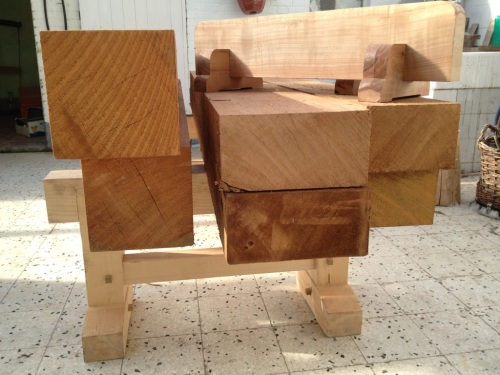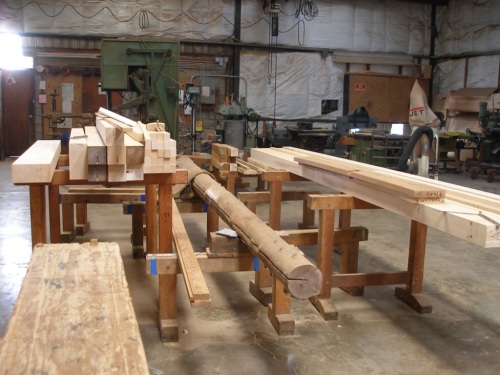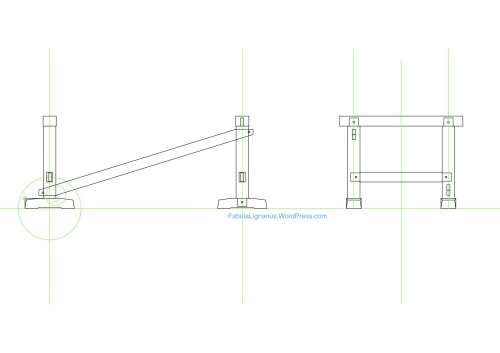Japanese Sawhorses, a Build Tread
by Mathieu
I have come across question like “How does a Japanese workbench look like, do Japanese carpenters work on a workbench or do they always sit on the floor?”
Well obviously I can’t really tell you since I am not Japanese. I was lucky enough to be trained by Japanese carpenters and worked along the side of western carpenters who received a long and tedious training in Japan, so I can only tell you about the way we work. Or better said, the way I was trained to work and how I have been working the last couple of years. Why do I choose to work like this? Because it suits me and I feel personally attracted to it for so many reasons that I can’t possibly write them all down.
Here is a picture of two pair of sawhorses I made a while ago. The small ones on top are meant to be used working low to the ground or while sitting in front of them. The design is inspired on some I have seen in Japan and you can also find them in Toshio Odate’s book ‘Japanese Woodworking Tools’. They are made of Cherry that I salvaged from a half burned tree in the back of the garden. I succumbed and did some simple carvings on them.
Below that beautiful lumber you see a pair that I knocked together fairly quickly. Nothing special but they do what they suppose to do and are strong and stable.
There is no such thing as a Japanese workbench or at least no device as we know them in the Western world with leg or tail vises or other mechanics. The closest equivalent would be a thick slab with low legs raising the slab to about 20cm, sometimes made out of sakura (Cherry) and with a planing stop dovetailed at the end.
Some Statements
So I am sorry for those who are looking for another build tread of a Roubo workbench but I will surely disappoint you. There is a vast amount of blog posts, articles and books out there that will still your hunger if that’s what you are looking for. To be honest I feel sorry for carpenters who mainly rely on a workbench to do any work. Why on earth would you like to limit yourself to the workspace of your shop with it’s bench? And then there are those who actually drag these 160 kilogram monsters to the job site which I think is even more insane. Of course they are great tools and I am just being provocative but nonetheless I want to make a statement. I have thought about building one myself for many years but the truth is that I never really needed one, I could always get all the work done just as easy without the need for such a fancy device. Besides it would take me forever to build one I really like, never mind the costs. I guess I like the minimalistic approach of shokunin.
So if you are not solemnly a joiner who only works in his workshop, this and the following post might be valuable to you. Working on a pair of sawhorses instead of a workbench is a simple but very efficient way of establishing a comfortable place to do any kind of woodwork you can imagine. Sawhorses turn any place that is covered from rain and direct sunlight into a potential workshop, and yes that includes your kitchen.
Prerequisites
The sawhorses we will discuss are not the first pair I make, many have preceded these and as far as I know they are all still in use and in good condition. For this new pair however I had some specific demands in mind which I will list first.
- high enough to do layout on them comfortably
- high enough to receive a planing beam
- stable so they will not move during planing
- light for easy transportation
- compact
- strong and durable
- not take forever to make
I like simple, humble but efficient designs. They don’t need to have pretty carvings, sophisticated angles or special details just good proportions that feel right and a silky smooth hand planed finish will give them a balanced feel and look. But since I actually do like all of the above I will put some extra details in this new pair. Just remember to leave the details behind if you want to set up a workshop in a matter of a day.
The Materials
Originally I was thinking to use Siberian Larch but I couldn’t find anything dry of the right dimensions. It is incredibly durable but would be too heavy anyway. Clear and tight-grained Oregon Pine would have been nice but was not available in the dimension I was looking for. At my local supplier I found some old grown Western Red Cedar. I hear you thinking saying it is too soft but I disagree. WRC is very durable yet very light which is important for tall horses to be manageable. And yes it is very soft and will get dings and scratches but that is ok since it is a sawhorse and it is meant to be used. It is a tool, not a piece of furniture.
I had clients commenting on them in two occasions saying they look as good as a piece of furniture. Well it is nice to receive a compliment but I did think ‘hey, they are just a pair of sawhorses’.
The Design
I could have drawn a CAD drawing but what I had in mind is so straight forward that I could just lay it out and build it. No need to waste any time on drawing when everything is crystal clear in your mind. But to give you an idea here is a picture of something similar.
The pair on the right with the stretchers at the bottom is what I have in mind. I know out of experience that they are not incredibly stable. So to increase their stability I will lengthen their feet and foresee some extra mortices so I can install diagonal bracings between them that can easily be removed. This should make a stiff connection so that they don’t wobble when I use them to hold a planing beam.
But since I hope some of you might build a pair of your own I went to the drawing board and made a quick mock up. This will enable me to share all the drawings with you and aid me during my explanations. Here is a little preview.
In the next post we will discuss the design and talk about kiwari or the proportions of all the members and how they relate to each other. After dimensioning it will be layout and then some simple joinery fun. I will make a material list and detailed drawings available.
You are welcome to leave a comment if you have any questions. And if you have any good ideas yourself please share them and maybe I will incorporate them in the next pair I’ll make. You can never have enough sawhorses.
∴




Hi, I am really glad the blog is not dead 🙂 Look forward to upcoming Posts, including the second post on the sawhorses 😉
LikeLike
Hi Dieter,
I am happy to hear you are still enjoying the blog.
I will make an effort to continue that series. Because of the workload at the moment I have to direct my priorities to the ongoing project for now. But no worries there will be more on those sawhorses.
LikeLike
Great !!! I can really use a pair of sturdy sawhorses . Best wishes for the new year.
LikeLike
Thank you for the wishes Dieter. Stay tuned..
LikeLike
Hi Mathieu
Thank you for writing this post.
Have you done some more work on this project? I am currently doing some work on job site workbenches in Norway and are soon going to make some trestles for a kind of planing beam. I am thinking of a working height of 73-75 cm (the top of the 4″ thick beam). Do you have any measures of your saw horses.
LikeLike
Dear Roald,
Thank you for the questions. Unfortunately it seems very difficult for me to continue the series on the sawhorses. Professional work seems to eat up almost all my time. I hope I answered your question in this post.
LikeLike
Dear Mathieu
Thank you for your ansver and your posting. That was very useful for me. I have made one of the trestles for my planing beam and posted some pictures on my blog.
LikeLike
Hi Roald, I am happy to see that those posts were inspiring to you. Although I can’t read the text I find the horses where one of the “hornes” is cut off interesting. I suppose you did this to make a more stable planing beam?
LikeLike
Hi Mathieu.
The text is Norwegian so it is hard to understand if you dont read that language. The horses are going to be used for a planing beam. I have found an old beam that have been used for this purpose, but the horses are missing. Therefore I have been searching around for inspiration about how to make the horses.
The “cut off” horn is to make the planing beam more stable. I am also thinking about using the side of the horses to fix wide boards on the edge. It could be a wild shot but I want to try. I have not cut the other horn so I could try to use the other side that has overhang. I will post again about this later.
LikeLike
Hello again, I am slowly progressing through your blog – moving backwards in time – while you progress through it forwards!
I know this subject kind of ended unfinished, but I’m curious how you were going to attach the removable diagonal brace. It goes through a mortise in the leg, but how is it held in place (looks like a pin of some kind)? A bolt?
LikeLike
Hi Darrell,
That is correct the tread is not finished yet but I am happy to reveal how I would join the brace to the leg.
There will definitely not be any bolts that is for sure.
The tenor will go true the notice protruding the other side with sufficient length.
There will be a wedge morticed true the tenon on the protruding side pulling the shoulders of the brace against the post. This is why you need sufficient length on the protruding end otherwise the wedge will break out a portion of the tenon.
I hope this clarifies the joint.
LikeLike
Great idea sharing this posts. This post is really important and informative. Useful article info sharing for everyone. I love this blog.
LikeLike